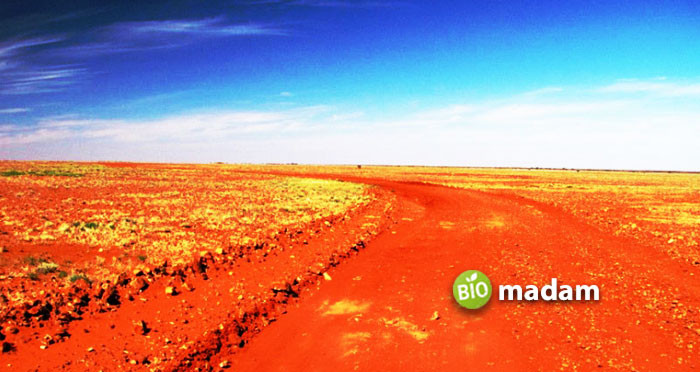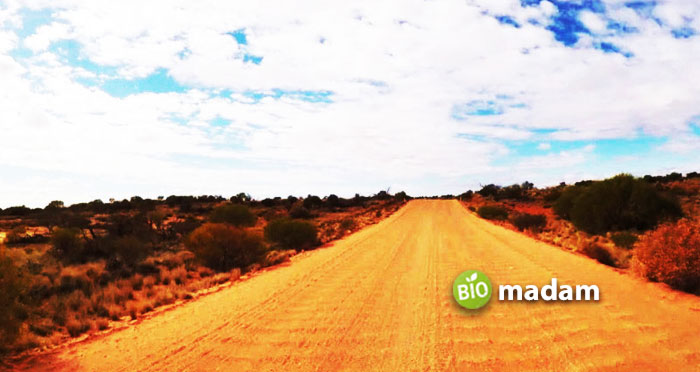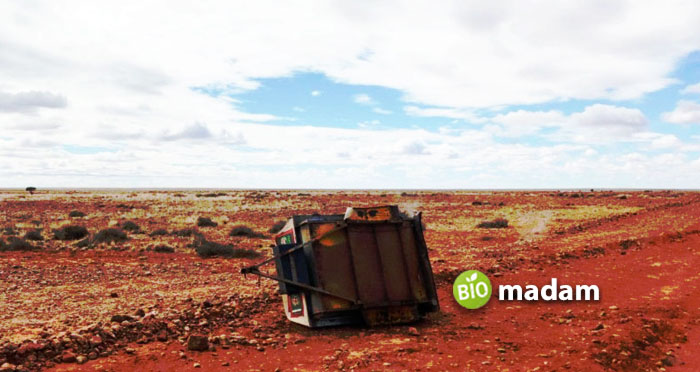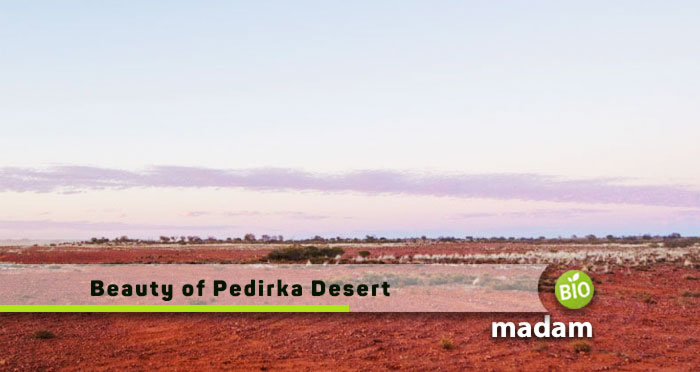Australia’s vast interior is home to immense desert wildernesses that showcase the country’s rugged natural beauty. One such mesmerizing landscape is the Pedirka Desert, a remote expanse in South Australia distinguished by its iconic parallel red sand dunes. This desert wonderland holds unique surprises beyond the iconic dunes, featuring rare flora and fauna eking out an existence in the arid environment.
For intrepid travelers seeking to uncover the magic of the outback, the Pedirka Desert, just like other popular deserts, offers a world of adventure, scenic vistas, and opportunities to delve into the resilience of nature. This captivating region reveals both struggle and beauty in the heart of the desert through its intricate environmental features, history of human exploration, and the need for thoughtful conservation of its fragile ecology. Come discover what makes the Pedirka Desert an Australian treasure.
Where is Pedirka Desert?
The Pedirka Desert is a small desert located in South Australia, Australia. It is situated approximately 100 kilometers northwest of Oodnadatta and about 250 kilometers northeast of Coober Pedy. The desert is positioned in the southern part of the Finke bioregion, straddling the Northern Territory/South Australian border. Mount Dare and Witjira National Park are located just to the north of the Pedirka Desert. The desert is part of the vast and diverse Australian outback, known for its arid landscapes and unique ecosystems.
Geographic and Environmental Features
The Pedirka Desert is a vastly expansive region characterized by its iconic fiery red sand dunes that stretch as far as the eye can see. While the dunes themselves are relatively low and flattened, they align in long parallel ridges that create a hypnotizing wave-like pattern across the landscape. Interspersed between the dunes are flat stony tablelands known as gibber plains, covered in small pebbles and rocks.
One of the most distinctive features of the Pedirka are the expansive white claypans that cut through the red dunes, creating a stark color contrast. The largest of these is the massive Fogarty Claypan, spanning an impressive 9 km in length. After rains, these claypans transform into shimmering shallow lakes that attract diverse birdlife.
The spaces between the dunes and claypans are blanketed in rich vegetation, featuring rolling mulga woodlands dotted with slender trunked trees, and vast spinifex grasslands that add texture. Various acacia shrubs and other desert flora flourish in this arid environment. Overall, the mosaic of fiery red sands, white claypans, rugged mountains, and diverse vegetation makes the Pedirka Desert a truly unique and mesmerizing Australian landscape.

Pedirka Desert Climate
The Pedirka Desert is characterized by its arid and hot climate, defining the harsh conditions of this remote expanse. Key features of the desert’s climate include:
- Low Rainfall: The Pedirka Desert experiences meager rainfall, with an annual average of only 152 mm recorded from 1890 to 2005. This scarcity of precipitation contributes to the arid nature of the region, shaping its unique ecosystems.
- High Evaporation Rates: The combination of intense heat and low humidity results in high evaporation rates in the Pedirka Desert. This climatic factor further contributes to the aridity of the landscape.
- Limited Rainfall over the Years: Over the years, the desert has consistently received less than 10 inches of rainfall annually. This climatic characteristic influences the flora, fauna, and overall ecology of the Pedirka Desert, where adaptation to water scarcity is a crucial aspect of survival.
The arid conditions, with minimal rainfall and high evaporation, play a pivotal role in shaping the captivating landscapes and ecological adaptations found within the Pedirka Desert.
Pedirka Desert Temperature
The temperature profile of the Pedirka Desert showcases notable variations between the summer and winter months.
Summer (December to February)
- Daytime Temperatures: The summer months bring scorching temperatures, with maximum daily averages ranging between 36.3 and 37.6°C. These blistering days are characterized by intense heat and a reliance on sun protection measures.
- Overnight Temperatures: Evenings remain relatively warm, with overnight minimums averaging between 21.1 and 22.7°C. The nights offer some relief but still retain a level of warmth.
Winter (June to August)
- Daytime Temperatures: Winter introduces milder temperatures, with maximum daily averages between 19.5 and 22°C. Days are generally moderate, offering a reprieve from the intense summer heat.
- Overnight Temperatures: Nights become cooler, with overnight minimums ranging between 5.8 and 7.4°C. While not freezing, the evenings can have a refreshing coolness.
- Wind Impact: Winter days can feel moderately cool, particularly if accompanied by wind, with temperatures dropping to around 19.5°C.
Recommendations
- Summer: Sunscreen, hats, and ample water are essential during summer to combat the intense heat. Carrying a portable personal air conditioner is recommended for added comfort.
- Winter: Despite milder temperatures, wearing a hat is advised to protect against the elements, especially if windy conditions prevail.
Flora and Fauna
The plants and animals of the Pedirka Desert are connected in a delicate balance of life. Different types of tough plants grow in the desert, providing food and shelter for the animals that live there.
Pedirka Desert Plants
Woodland Marvels
- Hakeas (Genus Hakea): Graceful and adaptable, hakeas contribute to the Pedirka Desert’s low open woodland. Their unique foliage adds a touch of elegance to the arid landscape.
- Grevilleas (Genus Grevillea): Vibrant and diverse, grevilleas thrive in the desert environment, enriching the flora with their varied shapes and colors.
- Mulga (Acacia aneura): A resilient member of the acacia family, mulga dominates the low open woodland, providing essential habitat and contributing to the desert’s overall ecosystem.
- Turpentine Mulga (Acacia brachystachya): Characterized by its distinctive appearance, the turpentine mulga stands as a testament to the desert’s ability to sustain diverse acacia species.
Dune Dwelling Shrubland
- Hakeas and Grevilleas: The sand dunes host a tall shrubland, where hakeas and grevilleas reach for the sky, creating a visually striking environment against the backdrop of the dunes.
- Umbrella Bush (Acacia ligulata): Resilient and adaptive, the umbrella bush thrives in the challenging conditions of the Pedirka Desert, offering shade and shelter in the dune shrubland.
- Grassy Understorey (Aristida spp.): The grassy understorey, dominated by various species of Aristida, completes the intricate flora tapestry, providing a vital ground layer within the desert ecosystem.

Pedirka Desert Animals
Potential Inhabitants
- Princess Parrot (Polytelis alexandrae): A colorful and elusive species, the Princess Parrot may find refuge in the diverse woodlands of the Pedirka Desert.
- Grey Falcon (Falco hypoleucos): A majestic raptor that could potentially navigate the desert skies in search of prey.
- Australian Bustard (Ardeotis australis): An iconic ground-dwelling bird that might find a habitat in the expansive plains and woodlands.
- Plains Wanderer (Pedionomus torquatus): A unique and ground-dwelling bird species that could inhabit the grassy understorey of the desert.
- Plains Rat (Pseudomys australis): A small mammal species that might navigate the dunes and shrublands.
- Southern Marsupial Mole (Notoryctes typhlops): A rare marsupial mole that could inhabit the sandy expanses, adapting to the desert’s unique conditions.
In the vast expanse of the Pedirka Desert, this diverse array of flora and fauna paints a vivid picture of adaptation and survival in an arid environment.
Human Interaction and Development
People have traveled through and developed the Pedirka Desert over time. An old rail line called the Old Ghan used to run near the main road going through the desert. The Old Ghan trains once struggled to move across the uneven sandy tracks. An abandoned train stop called Pedirka Siding still stands today as a reminder of the hard journey by train.
Even though the desert can be harsh, people are building it up more over time. Good paved roads now cut through the dunes to reach nearby towns like Hamilton and Finke. The roads make travel easier than it used to be.
At first, the desert did not appeal to ranchers because of the hot, dry land. But ongoing building shows the potential of the area. Bit by bit, human activity and development shape the Pedirka Desert while being challenged by its extreme conditions. The history of people in the desert reveals both struggle and hopeful progress.
Threats and Conservation
Despite its captivating beauty, the Pedirka Desert faces threats to its delicate ecosystem.
Threats
- Introduced Predators: Foxes and feral cats that were brought to Australia have had devastating impacts on native fauna. These skilled hunters have caused local extinctions of multiple small mammal species like the crest-tailed mulgara and lesser bilby. Their predation puts continuing pressure on vulnerable natives.
- Invasive Buffel Grass: This tough African grass has spread aggressively in the Pedirka region. Buffel grass outcompetes native flora, transforms habitat, and increases fire risk and intensity. It fuels hot fires that native plants cannot recover from.
- Climate Change: Rising temperatures and shifting rainfall patterns threaten the desert ecosystem. Prolonged drought stresses vegetation and fauna. Changes can disrupt the ecological balance.
- Overgrazing: Livestock grazing, if not carefully managed, can degrade fragile desert environments through soil erosion, vegetation trampling, and competing for resources.
- Uncontrolled Off-road Driving: Vehicles going off marked tracks damage fragile cryptogam crusts and can kill slow-moving fauna. This disturbs the landscape and ecosystem.
Conservation
- Monitoring Ecosystems: Scientists closely track threatened native flora and fauna. Wildlife cameras and surveys help understand population changes.
- Feral Animal Control: Intensive baiting, trapping, and culling of invasive predators across the landscape. Removing feral cats protects multiple small mammal species.
- Weed Removal: Ongoing mechanical clearing and herbicide spraying to control buffelgrass infestations. Prioritizing high conservation areas.
- Protected Areas: Parts of the Pedirka have protected area status, like the Dalhousie Springs Reserve. This regulates use and prevents unrestrained impacts.
- Habitat Restoration: Trials are underway to rehabilitate native vegetation in degraded areas. Strategic revegetation to provide food and shelter for threatened mammals.
- Sustainable Tourism: Strict rules for responsible four-wheel driving. Avoid damage to cryptogam crusts by sticking to designated tracks.
- Community Awareness: Engaging the public on issues like weed control and fire management helps reduce detrimental bush practices.
Pedirka Desert Facts
Here are some interesting facts about the Pedirka Desert:
- The Pedirka Desert derives its name from the Pedirka River, a watercourse that occasionally flows through the region. The term “Pedirka” is of Aboriginal origin, adding a cultural layer to the desert’s nomenclature.
- The desert features intriguing geological formations, including unique rock patterns and ancient landscapes shaped by natural forces over millennia.
- Unlike some more well-known deserts, the Pedirka Desert is sparsely populated, contributing to its untouched and pristine allure. The isolation adds to the sense of adventure for those exploring its vast expanses.
- With minimal light pollution, the Pedirka Desert offers an unparalleled stargazing experience. On clear nights, the sky becomes a canvas of stars, providing a breathtaking celestial display.
- The historic Old Ghan railway line, which once connected Adelaide to Alice Springs, passes through the Pedirka Desert. Exploring remnants of this railway adds a touch of nostalgia to the desert experience.
- Apart from its iconic dunes, the Pedirka Desert is home to salt lakes and mound springs. These unique features punctuate the landscape, showcasing the desert’s diverse ecosystems.
- The claypans and water sources in the Pedirka Desert attract a variety of bird species. Birdwatchers can spot both migratory and resident birds, adding to the region’s ecological richness.
- The Pedirka Desert experiences extreme temperature variations, with scorching summer days reaching high temperatures and winter nights bringing a noticeable coolness to the arid landscape.
- Despite its remote location, the Pedirka Desert faces conservation challenges, including threats from invasive species and climate change. Conservation efforts are crucial to preserving the delicate balance of its unique ecosystem.
- For enthusiasts of off-road driving and adventure, the Pedirka Desert provides a challenging terrain to explore, with opportunities for both seasoned adventurers and those seeking a taste of the outback experience.
Things to Do in Pedirka Desert
The Pedirka Desert, a hidden gem in the heart of South Australia, beckons with its unique landscapes and captivating charm. Explore the desert’s wonders with a variety of activities that promise an unforgettable experience.

Scenic Drives
Driving through the Pedirka Desert is an amazing way to see its beauty. The constantly changing views of red sand dunes and white claypans are like a work of art. Exploring the vibrant and colorful landscape along the desert roads is a special experience for travelers who enjoy natural scenery.
Exploration
- Sunrise at Duff Creek: Watch the sunrise light up the sky with orange and pink hues reflected on the desert sands at Duff Creek. It’s a stunning way to start the day.
- Algebuckina Bridge: Climb the hill at Algebuckina Bridge for awesome panoramic views from the top. Get a close up look at this cool old bridge over the Neale River too.
- Algebuckina Rail Bridge: Check out the historic rail bridge near the road bridge. Its weathered wood and steel tell the story of trains in the desert long ago.
- The Pink Roadhouse, Oodnadatta: Stop at the bright pink roadhouse in Oodnadatta on your drive. It’s a lively, colorful place for travelers to rest and refuel.
Epic Adventure
Beyond the main roads, the Pedirka Desert has hidden surprises waiting to be explored. Salt lakes with crystal shimmers and bubbling mound springs create oases in the harsh land. For adventurers willing to go off the beaten path, a walk into the diverse landscapes of the Pedirka Desert reveals its magic and beauty. Every new sights uncovers another chapter in the desert’s remarkable story.
Final Words
The Pedirka Desert is like a special part of Australia’s wild and vast outback. It’s full of amazing things from its fiery sand dunes to colorful claypans. But, this unique place needs our help to stay safe. Development and some plants and animals that don’t belong here can cause problems for desert life. If you’re someone who loves adventure and wants to experience the quiet beauty of the outback, the Pedirka Desert is a great place to explore. Remember, it’s important to be careful here and respect the natural beauty and history of this special place. In this dry and tough land, you’ll discover a unique and wonderful world that has fascinated people for a very long time.

As a freelance journalist, copywriter, and editor, Rachel Truman crafts compelling stories across travel, food, family, lifestyle, and B2B. With a keen eye for detail, Rachel specializes in creating engaging branded content, making every word an adventure

